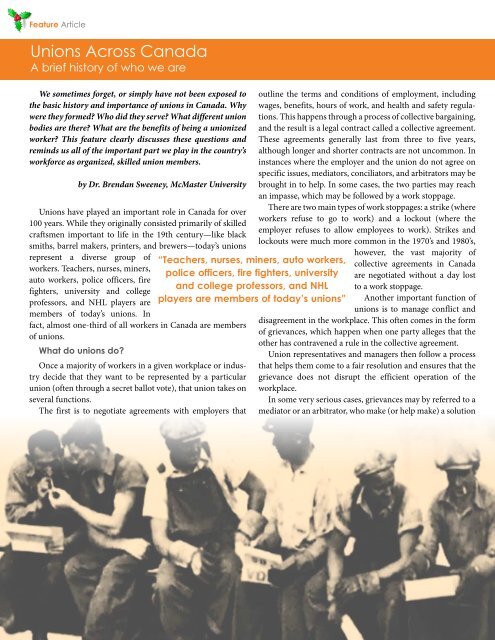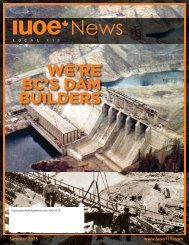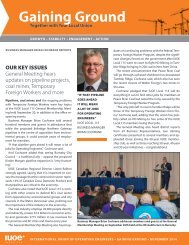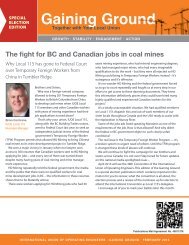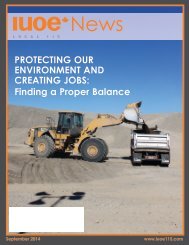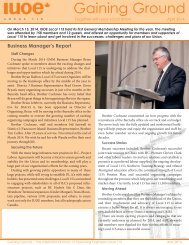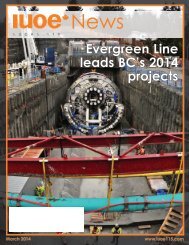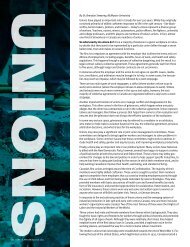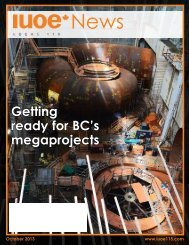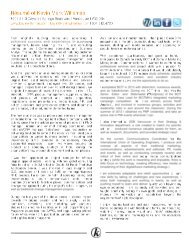IUOE News Winter 2013
The December 2013 issue of the OE News from IUOE Local 115 contains updates for all equipment operators and union supporters in BC. Enjoy!
The December 2013 issue of the OE News from IUOE Local 115 contains updates for all equipment operators and union supporters in BC. Enjoy!
Create successful ePaper yourself
Turn your PDF publications into a flip-book with our unique Google optimized e-Paper software.
Feature Article<br />
Unions Across Canada<br />
A brief history of who we are<br />
We sometimes forget, or simply have not been exposed to<br />
the basic history and importance of unions in Canada. Why<br />
were they formed? Who did they serve? What different union<br />
bodies are there? What are the benefits of being a unionized<br />
worker? This feature clearly discusses these questions and<br />
reminds us all of the important part we play in the country’s<br />
workforce as organized, skilled union members.<br />
by Dr. Brendan Sweeney, McMaster University<br />
Unions have played an important role in Canada for over<br />
100 years. While they originally consisted primarily of skilled<br />
craftsmen important to life in the 19th century—like black<br />
smiths, barrel makers, printers, and brewers—today’s unions<br />
represent a diverse group of<br />
workers. Teachers, nurses, miners,<br />
auto workers, police officers, fire<br />
fighters, university and college<br />
professors, and NHL players are<br />
members of today’s unions. In<br />
fact, almost one-third of all workers in Canada are members<br />
of unions.<br />
What do unions do?<br />
Once a majority of workers in a given workplace or industry<br />
decide that they want to be represented by a particular<br />
union (often through a secret ballot vote), that union takes on<br />
several functions.<br />
The first is to negotiate agreements with employers that<br />
“Teachers, nurses, miners, auto workers,<br />
police officers, fire fighters, university<br />
and college professors, and NHL<br />
players are members of today’s unions”<br />
outline the terms and con ditions of employment, including<br />
wages, benefits, hours of work, and health and safety regulations.<br />
This happens through a process of collective bargaining,<br />
and the result is a legal contract called a collective agreement.<br />
These agreements generally last from three to five years,<br />
although longer and shorter contracts are not uncommon. In<br />
instances where the employer and the union do not agree on<br />
specific issues, media tors, conciliators, and arbitrators may be<br />
brought in to help. In some cases, the two par ties may reach<br />
an impasse, which may be followed by a work stoppage.<br />
There are two main types of work stoppages: a strike (where<br />
workers refuse to go to work) and a lockout (where the<br />
employer refuses to allow employees to work). Strikes and<br />
lockouts were much more common in the 1970’s and 1980’s,<br />
however, the vast majority of<br />
collective agreements in Canada<br />
are negotiated without a day lost<br />
to a work stoppage.<br />
Another important function of<br />
unions is to manage conflict and<br />
disagreement in the workplace. This often comes in the form<br />
of grievances, which happen when one party alleges that the<br />
other has contravened a rule in the collective agreement.<br />
Union representatives and managers then follow a process<br />
that helps them come to a fair resolution and ensures that the<br />
grievance does not disrupt the efficient operation of the<br />
workplace.<br />
In some very serious cases, grievances may by referred to a<br />
mediator or an arbitrator, who make (or help make) a solution<br />
26 <strong>News</strong> December <strong>2013</strong>


